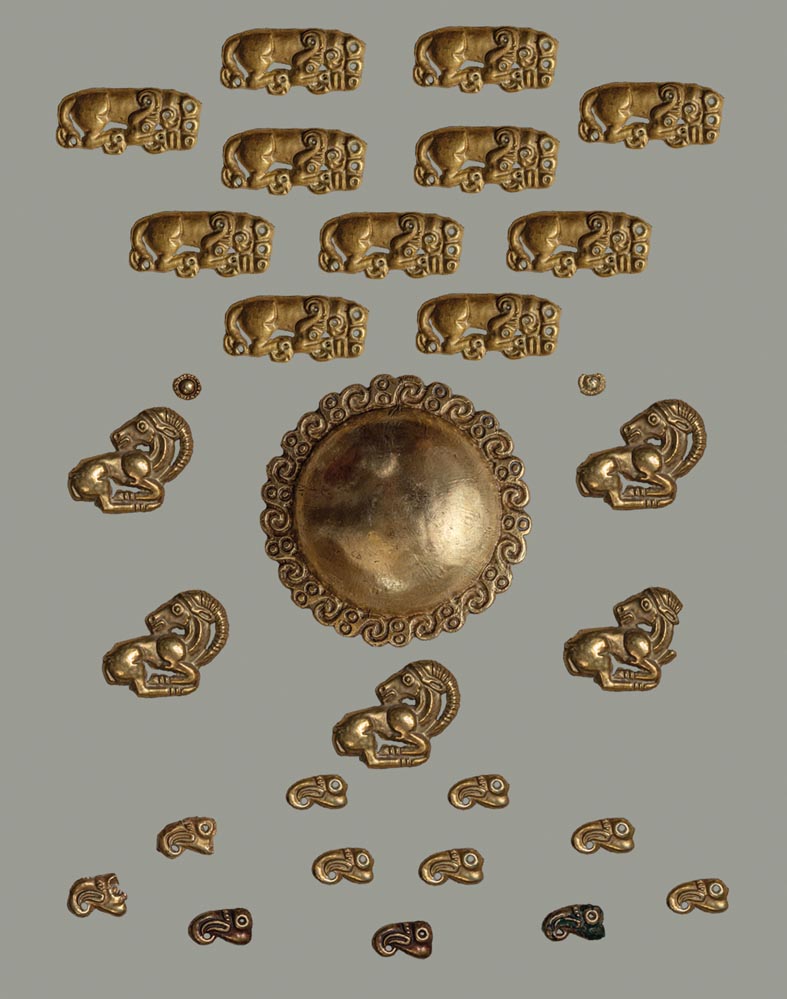Випуск 7. Вітова могила
У 1888 році український археолог Іван Зарецький дослідив курган Вітова могила, неподалік Опішні, в долині р. Мерла, де виявив багате воїнське поховання рубежу VI—V ст. до н. е. Земляний насип цієї поховальної споруди вирізнявся розмірами на тлі інших курганів в околиці. Поховання супроводжувалося значною кількістю інвентарю, що вказувало на високий соціальний статус похованого.
Серед знахідок — предмети озброєння, у тому числі сагайдак з берести, обтягнутий хутром й прикрашений композицією із золотих бляшок, виконаних у скіфському звіриному стилі. Центральне місце посідала велика кругла опукла бронзова бляха, вкрита золотом. По верхньому краю сагайдака були нашиті одинадцять золотих бляшок у вигляді фігурок пантер з петельками на обороті, по низу — шість золотих бляшок у вигляді фігурок гірських козлів у галопі, з повернутими назад головами. По краю напівкруглого дна сагайдака містилося одинадцять золотих бляшок у вигляді орлиних головок із загнутим дзьобом, а чотири його кута оздобили маленькими круглими опуклими золотими бляшками-розетками. У сагайдаку виявили понад 200 бронзових наконечників стріл. У похованні також зафіксували деталі кінської вузди та інші предмети.
Проведені Іваном Зарецьким розкопки повністю вичерпали його фінансові ресурси та підірвали дослідницькі прагнення науковця. Він вдався до пошуку додаткових грошей деінде. Скориставшись скрутою українського вченого, Московське археологічне товариство нав’язало Іванові Зарецькому кредит, умовою погашення якого стало придбання Російським історичним музеєм у Москві звіту та всієї колекції знахідок майже за безцінь. У підсумку, речі з його розкопок й досі зберігаються у Державному історичному музеї, а документація розпрошена по різними архівним установам Росії.
Юрій Пуголовок,
кандидат історичних наук, заступник Голови правління ВГО “Спілка археологів України”
Release 7. Vitova Mohyla
In 1888, the Ukrainian archaeologist Ivan Zaretsky investigated the burial mound of Vitova Mohyla, located near Opishna, in the valley of the Merla River. A rich military burial dated around the turn of the 6th—5th century BC was discovered in it. The dimensions of the earthen mound of this burial structure distinguish it from other mounds in the vicinity. The burial contained a significant number of inventory, which indicated the high social status of the buried person.
Among the finds were weapons, including a saadak (quiver) made of birch bark and covered with fur. It was decorated with gold plaques composition made in the Scythian animalistic style. A large round convex bronze plate covered with gold was placed at the center. On the upper edge of the quiver were sewn eleven gold plaques in the form of figures of panthers with hooks on the reverse. Six gold plaques in the form of figures of mountain goats in a gallop, with their heads, turned back were sewn on the bottom. Along the edge of the semicircular bottom of the quiver were placed eleven gold plaques in the form of eagle heads with bent beaks, and at its four corners were small round convex gold rosette plaques. More than 200 bronze arrowheads were found in the quiver. Fragments of a horse bridle and other items were also discovered in the burial.
The excavations conducted by Ivan Zaretsky completely exhausted his financial resources and undermined the scientist's research aspirations. He tried to search for additional funding elsewhere. Taking advantage of the Ukrainian scientist's predicament, the Moscow Archaeological Society imposed a loan on Ivan Zaretsky. The loan terms were the purchase of the report and the entire collection of finds by the Russian Historical Museum in Moscow for almost nothing. As a result, artifacts from his excavations are still kept in the State Historical Museum, and the documentation is scattered among various Russian archival institutions.
Yurii Puholovok,
PhD, deputy chairman of The All-Ukrainian Рublic Association of Archaeologists

Знахідки з кургану Вітова могила, VI—V ст. до н .е. Зберігаються у Державному історичному музеї, Москва, Росія
Archaeological finds from the Vitova Mohyla burial mound, 6th—5th century BC. Stored in the State Historical Museum, Moscow, Russia
27.11.2022
Проєкт здійснено за підтримки Стабілізаційного фонду культури й освіти Федерального міністерства закордонних справ Німеччини та Goethe-Institut. goethe.de
The project is funded by the Stabilisation Fund for Culture and Education of the German Federal Foreign Office and the Goethe-Institut. goethe.de








